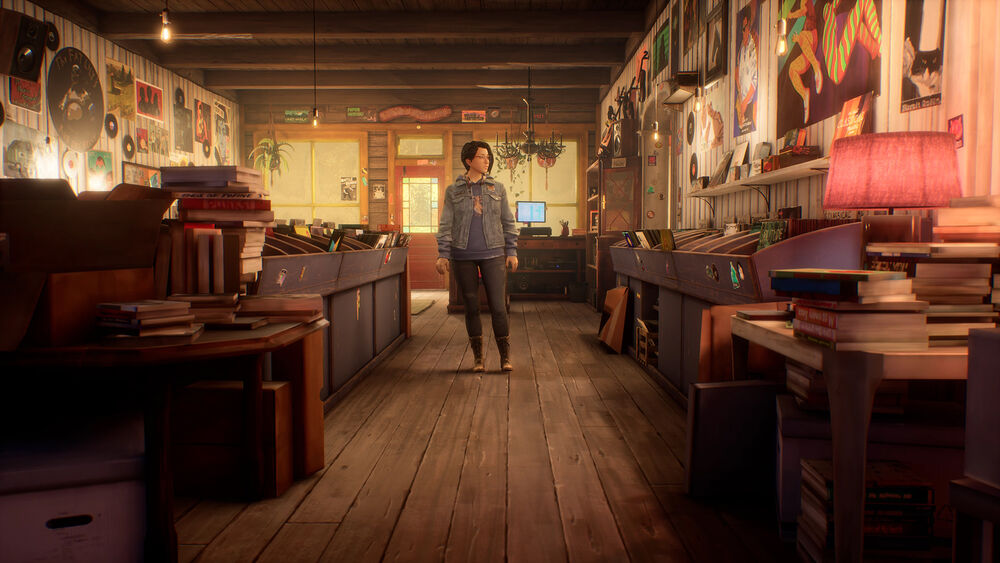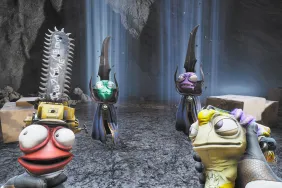Life is Strange is one of those video game series whose reception varies largely depending on who plays it, what choices they made during their playthrough, and, most importantly, how invested players get into the game’s characters. As a narrative-heavy experience, a lot of the game is spent talking to various characters, investigating for clues or interacting with items, and reading over in-game text to parse out the unseen—be it how characters feel, their motivations, or their troubled pasts.
The subject matter is often heavy, focusing on characters’ past trauma and the effect it has on present and future events. By and large, the series tasks players with navigating these complex characters and relationships often fraught with emotional baggage, and make decisions in order to reach a satisfying conclusion. Unfortunately, this also means that there is a myriad of ways that things can go wrong and—coupled with the fact that all past Life is Strange games featured teenage protagonists—often led to a certain amount of frustration with how story events play out.

Fortunately, Life is Strange: True Colors manages to alleviate a lot of these frustrations through the main character’s superpower of psychic empathy. Better yet, True Colors eschews much of the problematic, bordering-on-trauma-porn aspects of its predecessors to provide players with a story that focuses on healing rather than hurting. Not only are its representations of marginalized people respectful, but its facial animations are also a massive step up from previous titles and add unprecedented depth to character interactions.
In short, True Colors may in fact be the best Life is Strange game to date.
[I’ll try to avoid any major spoilers for the game in this review]
Life is Strange: True Colors Review – Welcome to Haven Springs
A majority of Life is Strange: True Colors takes place in the town of Haven Springs, situated in the mountainside of rural Colorado. Players are put in the shoes of Alex Chen, a former foster child who was recently found by her estranged older brother Gabe and invited to live with him in Haven Springs. Surrounded by mountains and scenic nature, the town is home to a handful of residents that know their neighbors well (and like with all rural towns, sometimes too well).
As the newest resident and little sister of Gabe Chen, the kind and charismatic bartender of the town, many of the residents are welcoming towards you—a rarity in past Life is Strange titles. All chapters are situated in Haven Springs, and rarely anywhere else. You interact with the same cast of characters over the course of several weeks, getting to know their relationships, histories, and if you make the right choices, their feelings, motivations, and secrets.
This isn’t a novel concept to the Life is Strange series, of course, but the key difference is that True Colors places you in a set location with a set cast that is almost always interactable in some form. Unlike Life is Strange 2 which brought you to a different location with each chapter, True Colors lets you feel like you’re getting used to a new home. And unlike Life is Strange and its spinoff Before the Storm, the people are almost never outwardly hostile (save for a few unsavory folks on MyBlock, the community’s social media app). The last point, in particular, is especially refreshing, as characters in previous installments would come off as absurdly dramatic and immature at times. By comparison, True Colors pulls off its drama with emotional maturity, making character interactions feel believable and more importantly, positive.

What’s more, though the game rarely shies away from talking about traumatic events and experiences, True Colors never portrays them in a voyeuristic light. One of the main issues I’ve had with past Life is Strange games was the problematic nature of portraying abuse against children—particularly those of racial or sexual minorities. There is even a particular scene in the last chapter of the game where that could have been possible. Fortunately, Deck Nine made a very clever creative choice that not only avoids showing violence against children but also acts as a meaningful device for the chapter’s overall theme.
The only gripe that I have with the game is that some character development can feel rushed at times, though that may be unavoidable considering the game only has five chapters taking place over the course of five separate days. However, the game does take its time where it counts, particularly with the two Chen siblings; Alex, who experienced first-hand the dark side of the foster care system, and Gabe, who had to survive through juvenile detention and leave his sister to fend for herself. As it stands, the game does an amazing job at telling the beautiful, sad, and ultimately hopeful story of two young adults that struggled through childhood to arrive at their very own haven.
Life is Strange: True Colors Review – More Than Meets the Eye
One of the key improvements made in True Colors is the game’s utilization of full performance capture. The difference is night and day, especially when you compare it to the facial animations in previous titles. The addition also proves itself to be incredibly valuable in connecting with characters and—you guessed it—feeling empathy towards them. The facial mocap also helps bring out the fantastic performances by Alex Chen’s voice actor Erika Mori, as well as Gabe Chen (played by Han Soto), Steph Gingrich (played by Katy Bentz), and Jed Lucan (played by Stephen Fuller Austin). And if you’re not feeling too empathetic, Anastasia Davidson does a killer job at portraying the plastic, corporate mouthpiece of Typhon Mining Company, Diane Jacobs.
There is remarkable attention to detail here, and I’m not exaggerating when I say that every character’s performance never feels stilted or unnatural. Little details like how a character’s eyes will look away from Alex when they’re caught lying, or how a love interest will enthusiastically lock eyes make all the difference, especially in a game that focuses so heavily on reading emotions. Additionally, because many scenes were filmed with the actors in the same space, character interactions and chemistry just feels that much more real.

Erika Mori agrees, stating in an interview with PCGames:
I think that having the ability to do full performance capture was instrumental in successfully creating this game about empathy because it allowed us to get really high-fidelity facial expressions that were organically connected to whatever was going on with my voice and body in a particular scene.
This is most evident in the scenes where Gabe and Alex interact, as the chemistry between Mori and Soto really does make it feel like two long-lost siblings reconnecting after years of being apart. If you don’t believe me, you can check out the behind-the-scenes footage of the two actors rocking out to some tunes.
That being said, there are a few issues on the technical side of things. Firstly, that there seem to be a few bugs in the game’s lighting system, as I was occasionally met with strange exposed light sources, particularly in scenes involving Alex’s psychic empathy ability. I also encountered some longer-than-expected loading times between areas, though that was less of an issue. Fortunately, that was the extent of it, and my overall gaming experience was fairly smooth.
Life is Strange: True Colors Review – You Feel Me?
As Alex is capable of tapping into characters’ feelings, there are four emotions present in the game: anger, fear, sadness, and joy. Throughout the game, certain characters (both major and minor) will occasionally have auras surrounding them, indicating that Alex can read them. This mechanic not only allows for better insight into the character’s background but can also unlock special dialogue, similar to Max’s photographic time travel in LiS and Daniel’s telekinesis in LiS 2. Furthermore, you can also interact with certain “emotionally charged” items to read into the psyche of the person it’s attached to, be it an umbrella used at a funeral, or a flower given to a love interest.

Let me just come out and say that I am an absolute sucker for redemption stories; I love being proven wrong. So when Square Enix announced that the next main character in the series could read people’s emotions and give players better insight into a character’s motivations, I was instantly hooked. No longer would I have to parse through dozens of documents and journal entries to find out a niche bit of information that would help me get the outcome that I wanted. If a character seemed like a bad person, all I would have to do is read their minds a la Professor X, find out how they actually felt, and make decisions accordingly.
As noted previously, a large portion of the game focuses on helping the residents of Haven Springs through this psychic empathy mechanic. It’s no surprise that the first thing I did was go around reading everyone’s thoughts and alleviating their worries. Alex, too—depending on how you play the game—will comment on this fact, going out of her way to detail particularly strong emotions in her journal. For the most part, the game gives you all the tools you need to analyze people’s feelings and motivations in concrete terms, rarely leaving anything to interpretation.
Yet, this focus on others, Alex’s incessant need to help others and keep the community together, is a red herring. For all her journal entries chronicling other characters’ feelings, the true focus is in fact on Alex herself; through analyzing others’ emotions, she analyzes her own. And as much as she attempts to deny and suppress her own emotions—understandable, considering how volatile she becomes when influenced by others’ rage—Alex sorely needs it.
Life is Strange: True Colors is just as much a story about Asian American heritage, mental illness, broken homes, and systemic failure as it is a drama centering around dealing with loss, regrets, and trauma. Alex, up until the events of the game, is forced to hide her emotions for fear of alienating everyone around her and appeal to potential foster homes. She despises her father—a first-generation Chinese immigrant—for leaving her and her brother after their mother died from an illness. Alex calls herself “broken,” and it’s only until she reunites with her brother Gabe that she finally begins the process of healing.
And that’s where True Colors‘ most vital aspect lies. To focus not just on healing others, but healing yourself. Letting yourself feel sad when a family member passes, feel angry at your parent for betraying your trust, and feel joy towards the absurd and mundane.
Who knows; you might just find someone that shares those feelings with you.
Life is Strange: True Colors review code provided by publisher. For more information, please read our Review Policy.
-
Fantastic gripping story
-
Character performances and animations are vastly improved
-
Writing and dialogue is natural
-
Respectful representation of Asian Americans and LGBTQ+
-
Slightly long loading times, occasional graphical glitches
-
Character development could have been done over a longer period of time
-
Made me cry twice








